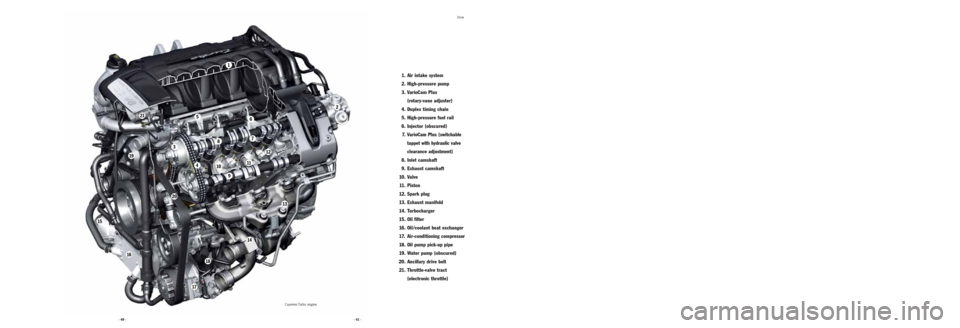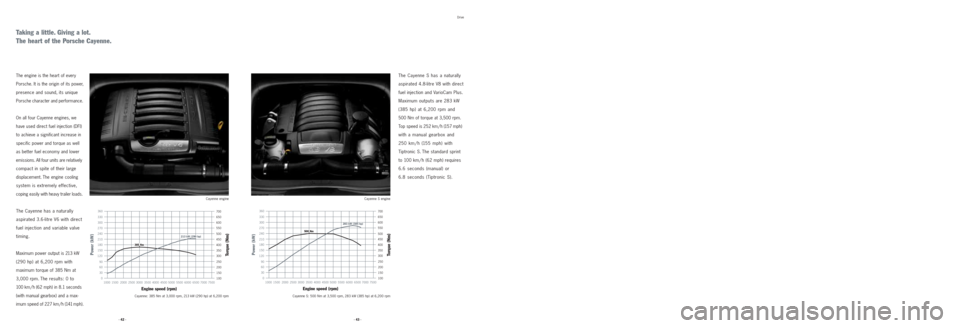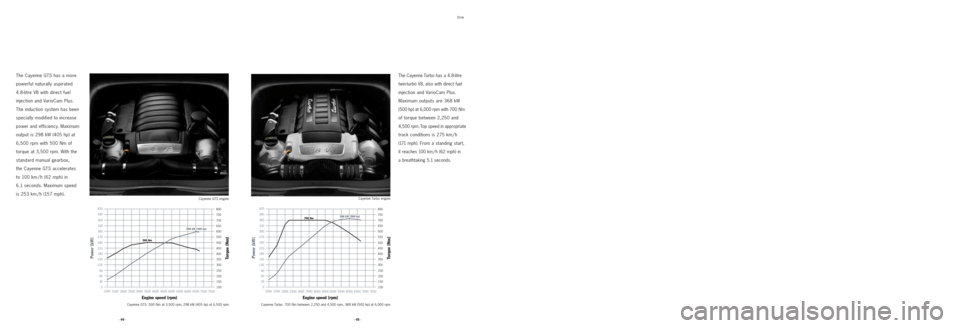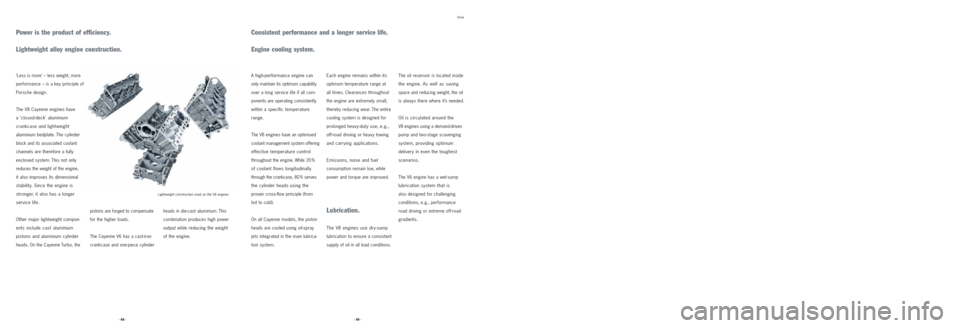engine PORSCHE CAYNNE 2008 1.G Information Manual
[x] Cancel search | Manufacturer: PORSCHE, Model Year: 2008, Model line: CAYENNE, Model: PORSCHE CAYENNE 2008 1.GPages: 95, PDF Size: 3.37 MB
Page 19 of 95

1. Air intake system
2. High-pressure pump
3. VarioCam Plus
(rotary-vane adjuster)
4. Duplex timing chain
5. High-pressure fuel rail
6. Injector (obscured)
7.
VarioCam Plus (switchable
tappet with hydraulic valve
clearance adjustment)
8. Inlet camshaft
9. Exhaust camshaft
10. Valve
11. Piston
12. Spark plug
13. Exhaust manifold
14. Turbocharger
15. Oil filter
16. Oil /coolant heat exchanger
17.
Air-conditioning compressor
18. Oil pump pick-up pipe
19. Water pump (obscured)
20. Ancillary drive belt
21. Throttle-valve tract
(electronic throttle)
Cayenne Turbo engine
1011
12
13
14
15
16
17
18
19
20
21
1
2
3
4
56
78
9
· 41 · · 40 ·
Drive
Page 20 of 95

100 300 350
400
450
500 550 600
6500 30
60 90 120150
180 210 240 270
300
3301500
7500 2000 2500 3000 3500 4000 4500 5000 5500 6000 6500 7000
150 200
250
1000
Power (kW)Torque (Nm)
Engine speed (rpm)
360700
283 kW (385 hp)
500 Nm
100 300 350
400
450
500 550 600
6500 30
60 90 120150
180 210 240 270
300
3301500
7500 2000 2500 3000 3500 4000 4500 5000 5500 6000 6500 7000
150 200
250
1000
Power (kW)Torque (Nm)
Engine speed (rpm)
360700
213 kW (290 hp)
385 Nm
Cayenne: 385 Nm at 3,000 rpm, 213 kW (290 hp) at 6,200 rpm Cayenne S: 500 Nm at 3,500 rpm, 283 kW (385 hp) at 6,200 rpm
The engine is the heart of every
Porsche. It is the origin of its power,
presence and sound, its unique
Porsche character and performance.
On all four Cayenne engines, we
have used direct fuel injection (DFI)
to achieve a significant increase in
specific power and torque as well
as better fuel economy and lower
emissions. All four units are relatively
compact in spite of their large
displacement. The engine cooling
system is extremely effective,
coping easily with heavy trailer loads.
The Cayenne has a naturally
aspirated 3.6-litre V6 with direct
fuel injection and variable valve
timing.
Maximum power output is 213 kW
(290 hp) at 6,200 rpm with
maximum torque of 385 Nm at
3,000 rpm. The results: 0 to
100 km / h (62 mph) in 8.1 seconds
(with manual gearbox) and a max-
imum speed of 227 km / h (141 mph).
The Cayenne S has a naturally
aspirated 4.8-litre V8 with direct
fuel injection and VarioCam Plus.
Maximum outputs are 283 kW
(385 hp) at 6,200 rpm and
500 Nm of torque at 3,500 rpm.
Top speed is 252 km / h (157 mph)
with a manual gearbox and
250 km / h (155 mph) with
Tiptronic S. The standard sprint
to 100 km / h (62 mph) requires
6.6 seconds (manual) or
6.8 seconds (Tiptronic S).
Cayenne S engine
Drive
Taking a little. Giving a lot.
The heart of the Porsche Cayenne.
Cayenne engine
· 43 · · 42 ·
Page 21 of 95

100 300 350
400
450
500 550 600
6500 30
60 90 120150
180 210 240 270
300
3301500
7500 2000 2500 3000 3500 4000 4500 5000 5500 6000 6500 7000
150 200
250
1000
Power (kW)Torque (Nm)
Engine speed (rpm)
360700
390750
298 kW (405 hp)
500 Nm
800420
100 300 350
400
450
500 550 600
6500 30
60 90 120150
180 210 240 270
300
3301500
7500 2000 2500 3000 3500 4000 4500 5000 5500 6000 6500 7000
150 200
250
1000
Power (kW)Torque (Nm)
Engine speed (rpm)
360700
390750368 kW (500 hp)700 Nm
800420
The Cayenne GTS has a more
powerful naturally aspirated
4.8-litre V8 with direct fuel
injection and VarioCam Plus.
The induction system has been
specially modified to increase
power and efficiency. Maximum
output is 298 kW (405 hp) at
6,500 rpm with 500 Nm of
torque at 3,500 rpm. With the
standard manual gearbox,
the Cayenne GTS accelerates
to 100 km / h (62 mph) in
6.1 seconds. Maximum speed
is 253 km / h (157 mph).
The Cayenne Turbo has a 4.8-litre
twin-turbo V8, also with direct fuel
injection and VarioCam Plus.
Maximum outputs are 368 kW
(500 hp) at 6,000 rpm with 700 Nm
of torque between 2,250 and
4,500 rpm. Top speed in appropriate
track conditions is 275 km / h
(171 mph). From a standing start,
it reaches 100 km / h (62 mph) in
a breathtaking 5.1 seconds.
Drive
Cayenne Turbo engine
Cayenne Turbo: 700 Nm between 2,250 and 4,500 rpm, 368 kW (500 hp) at 6,000 rpm Cayenne GTS engine
Cayenne GTS: 500 Nm at 3,500 rpm, 298 kW (405 hp) at 6,500 rpm
· 45 · · 44 ·
Page 22 of 95

440
400
360
320
280
24 0
20 0
160
120
80 900
850
800
750
700
650
600
550
500
450
2000 4000 6000
Our greatest motivation:
to exceed our own achievements.
Powerkit Cayenne Turbo.
The Porsche Turbo is a simple
concept: ultimate performance in
every respect. The Cayenne Turbo
continues this tradition with power,
dynamism and agility. This capability
can only be achieved when you’re
always striving to improve. Which
is why even the Cayenne Turbo
can offer increased power and,
with it, greater active safety.
The optional Powerkit Cayenne
Turbo increases maximum output
from 500 to 540 hp.
This is achieved using a new
intake manifold and a number
of modifications to the engine
management system. The result:
397 kW (540 hp) at 6,000 rpm.
Maximum torque is increased by
50 Nm to 750 Nm (between
2,250 and 4,500 rpm). Acceleration
to 100 km / h (62 mph) requires
just 4.9 seconds. Maximum speed
is 279 km / h (173 mph).
Even the engine compartment
immediately conveys the promise
of pure performance. Special
features include a throttle body
cover in carbon fibre and a plaque
in brushed aluminium. These are combined with a titanium-coloured
intake manifold with carbon inlays
and silver-coloured ‘turbo’ logo.
The propeller shaft has also been
revised to match the increased
loads. The overall result:
even greater exhilaration on
the racetrack, even greater
responsiveness on the road.
Drive
Powerkit Cayenne Turbo*
Fuel consumption**
Urban 22.5 l/100 km (12.6 mpg)
Extra urban 10.5 l/100 km (26.9 mpg)
Combined 14.9 l/100 km (19.0 mpg)
CO2emissionsCombined 358 g/km
· 47 · · 46 ·
397 kW
(540 hp)
Power (kW)
Torque (Nm)
Cayenne Turbo with Powerkit
Cayenne Turbo with standard engine
750 Nm
(2,250 – 4,500 rpm)
Engine speed (rpm)Cayenne Turbo engine with Powerkit
** Only available in conjunction with 19-inch Porsche wheels or larger (with requisite approval).
** Emissions were recorded in accordance with Directive 80/1268/ EC on standard vehicles as valid at the time of publication.
The respective figures were not recorded on individual vehicles and do not constitute part of the offer.
This data is provided solely
for the purposes of comparison between the respective models. For more information, pleasecontact your Porsche Centre.
Page 23 of 95

Power is the product of efficiency.
Lightweight alloy engine construction.
‘Less is more’ – less weight, more
performance – is a key principle of
Porsche design.
The V8 Cayenne engines have
a ‘closed-deck’ aluminium
crankcase and lightweight
aluminium bedplate. The cylinder
block and its associated coolant
channels are therefore a fully
enclosed system. This not only
reduces the weight of the engine,
it also improves its dimensional
stability. Since the engine is
stronger, it also has a longer
service life.
Other major lightweight compon-
ents include cast aluminium
pistons and aluminium cylinder
heads. On the Cayenne Turbo, the
pistons are forged to compensate
for the higher loads.
The Cayenne V6 has a cast-iron
crankcase and one-piece cylinderheads in die-cast aluminium. This
combination produces high power
output while reducing the weight
of the engine.
Drive
Lightweight construction used on the V8 engines
Consistent performance and a longer service life.
Engine cooling system.
Each engine remains within its
optimum temperature range at
all times. Clearances throughout
the engine are extremely small,
thereby reducing wear. The entire
cooling system is designed for
prolonged
heavy-duty use, e.g.,
off-road driving or heavy towing
and carrying applications.
Emissions, noise and fuel
consumption remain low, while
power and torque are improved.
Lubrication.
The V8 engines use dry-sump
lubrication to ensure a consistent
supply of oil in all load conditions.
The oil reservoir is located inside
the engine. As well as saving
space and reducing weight, the oil
is always there where it’s needed.
Oil is circulated around the
V8 engines using a demand-driven
pump and two-stage scavenging
system, providing optimum
delivery in even the toughest
scenarios.
The V6 engine has a wet-sump
lubrication system that is
also designed for challenging
conditions, e.g., performance
road driving or extreme off-road
gradients.
A high-performance engine can
only maintain its optimum capability
over a long service life if all com-
ponents are operating consistently
within a specific temperature
range.
The V8 engines have an optimised
coolant management system offering
effective temperature control
throughout the engine. While 20 %
of coolant flows longitudinally
through the crankcase, 80 % serves
the cylinder heads using the
proven cross-flow principle (from
hot to cold).
On all Cayenne models, the piston
heads are cooled using oil-spray
jets integrated in the main lubrica-
tion system.
· 49 · · 48 ·
Page 24 of 95

Controlling fuel delivery for optimum combustion.
Direct fuel injection (DFI).
Drive
designed to improve power, torque
and emissions. The swirling of the
injected fuel creates a homogenous
air/fuel mix, thereby enhancing
combustion.
At engine speeds up to 3,500 rpm,
a double injection process is used.
Here, the required fuel volume
is delivered in two successive
injections per working stroke. The
results are faster catalyst warm-up
and increased torque in the upper
load range. All four Cayenne engines feature
direct fuel injection.
As the name suggests, fuel is
injected directly into each
combustion chamber using electro-
magnetic injectors offering
extremely high precision in
terms of both timing and volume.
A high-pressure pump provides
the necessary pressure of up to
120 bar.
The injector position and spray
geometry have been carefully
From road to racetrack. At the push of a button.
‘Sport’ button.
Throttle response in ‘Sport’ mode
Throttle response
in ‘Normal’ mode
Both sets of characteristicsare dependent on engine
speed.
Pedal travel (%)
(%) Torque
(as percentage of maximum)
All Cayenne models have a
standard ‘Sport’ function with
a choice of comfort-oriented
(‘Normal’) or high-performance
(‘Sport’) setup.
When ‘Sport’ mode is enabled
using a button on the centre
console, the engine management
system selects a more ‘aggressive’
map for the electronic throttle.
The pedal response is quicker
and the engine more dynamic
and direct. On vehicles with
Tiptronic S, upshifts are performed
later, downshifts earlier. The
chassis control systems PASM
and PDCC (if present) are also
set to ‘Sport’ mode. Cars with
air suspension are lowered to
Low Level I, creating a firmer
ride, more positive turn-in and
better contact with the road.
The ‘Sport’ sound mode on the
sports exhaust system (standard
on Cayenne GTS; optional on
Cayenne S with Tiptronic S) is
also enabled when ‘Sport’ mode
is selected.
‘Sport’ button on centre console Comparison of electronic throttle map in ‘Normal’ and ‘Sport’ mode
By mixing the fuel and air directly
in the combustion chamber, DFI
contributes to engine cooling.
As a result, it was possible
to increase the compression
ratio and therefore output and
efficiency.
The engine management system
regulates the injection process
based on changing output require-
ments. Oxygen sensor circuits
are used to monitor emissions
and minimize impact on the
environment (see page 60). This
also reduces ownership costs.
· 51 · · 50 ·
Page 25 of 95

Plus selects the higher lift setting
and retards valve timing.
At medium revs and minimal
load, the valve lift is lowered and
timing advanced to minimise
fuel consumption and emissions.
At low engine speeds in particular,
VarioCam Plus significantly
The V6 engine in the Cayenne
features variable valve timing on
both inlet and exhaust.
The camshaft phase angles are
continuously varied by the engine
Increasing torque.
Reducing fuel consumption.
VarioCam Plus in the V8 and V8 turbo engines. The epitome of adaptability. And that’s just the engine.
Variable valve timing in the V6 engine.
management system via rotary-
vane
adjusters.
Each cylinder has four valves
actuated by roller cam followers
featuring hydraulic valve clearance
adjustment. The results: high
specific power and torque – even
at low engine speeds. Above all,
this technology improves fuel
economy while further reducing
emissions.
Drive
improves fuel economy. To achieve
maximum power and torque, the
valve lift is raised and the timing
advanced.
Overall, the system offers
greater reserves of power and
torque with relatively modest
fuel consumption.
VarioCam Plus creates two engines
out of one by steplessly adjusting
the inlet valve timing and lift.
The system differentiates between
normal road usage and performance
driving, adapting seamlessly as
driver inputs change. All functions
are automatically controlled by
the engine management system.
All
you experience is responsive
acceleration and ultra-smooth
running characteristics.
The valve lift system consists of
electro-hydraulically switchable
tappets.
Inlet valve timing is steplessly
varied using rotary-vane adjusters.
To improve response when starting
from cold for example, VarioCam
· 53 · · 52 ·VarioCam Plus (V8 engines)
Page 26 of 95

There is one fuel that will always be free.
Which is why we make the most of it.
Air intake system.
The Cayenne models are all
equipped with a resonance air
intake system. This simple
technology uses the pressure
waves generated by the inlet
valves to ‘force’ air into the engine.
The effect is enhanced in
the Cayenne, Cayenne S and
Cayenne GTS by a two-stage
intake manifold. This combines all
the benefits of a long intake tube
(higher torque at low rpm) with
those of a shorter length (more
power at higher rpm). On theCayenne GTS, performance is
enhanced by optimised airflow
management in the intake manifold.
Although ‘naturally aspirated’,
the Cayenne, Cayenne S and
Cayenne GTS provide high torque
ratings across the entire engine
speed range.
Drive
Pressure is often the key to performance.
Turbocharging system in the Cayenne Turbo.
The Porsche Turbo is synonymous
with performance, exhilarating
acoustics and the finest engineering.
The Cayenne Turbo has twin
turbocharger units arranged in
parallel. The low-volume intake
pipes combine with short exhaust
manifolds to achieve a rapid,
emphatic response.
Incoming air is passed through a
filter and compressed by the turbine
units. Its temperature is then
reduced in the intercooler system,
which improves cylinder charging
and limits thermal loads on the
engine.
Boost pressure reaches 1.8 bar
(absolute pressure) under full
acceleration from just 2,500 rpm.In normal road driving (part-throttle
mode), the pre-throttle boost
pressure is reduced in order
to
maximise fuel economy. When
the car is driven more assertively,
the
turbines are ‘pre-spun’ so
as to increase the pressure
available. When the throttle is
finally opened, the boost can
be applied immediately.
Both turbo units are cooled by
dedicated circuits from the main
engine cooling system.This solutionprevents oil degradation due to
overheating.
For the driver, the result is
seamless delivery of phenomenal
power and torque.
· 55 · · 54 ·
Page 27 of 95

· 58 · · 57 · · 56 ·
Used to regulate /control Input data Used to regulate /control
Engine management system
(MED 9.1)
Engine load
Throttle-valve angle
Oxygen sensor signals
Engine speed (from crankshaft)
Inlet camshaft phase angle
Knock sensor signals
Vehicle speed
Air-conditioning settings
Throttle pedal position
Temperatures
– Coolant
– Intake air
– Engine oil
– Ambient air
Zündung
Direct fuel injection (DFI)
Idling via throttle valve and ignition
Heating elements in oxygen sensors
Demand-controlled fuel pump
Fuel-tank venting
CAN interface to PSM control unit, transmission control unit, engine immobiliser, instrument cluster,
air-conditioning control unit, ‘Sport’ button, on-board diagnostics, etc.
Input data
Camshaft phase angle
Engine fan
Starter
Fuel pressure
Throttle valve
Intake manifold resonance valve
Engine management functions in the Cayenne S, Cayenne GTS and Cayenne Turbo. Engine management functions in the Cayenne.
Drive
Maximum freedom requires total control.
Electronic engine management.
The electronic engine management
system provides coordinated
regulation of all engine functions
and associated systems in all
operating conditions.
The basic principle of engine
management is simple. Throughout
each journey, the system monitors
a range of input data and compares
it with corresponding sets of
reference values (‘maps’). Key
engine functions, such as ignition
and fuel injection, can be seamlessly
and automatically adjusted. The
results: optimum fuel economy and
lower emissions as well as greater
power and torque.One of the most important systems
controlled by engine management
is the electronic throttle, a
prerequisitefor Porsche Stability
Management
(PSM). Other major
functions include on-board diagnos-
tics and cylinder-specific knock
control featuring automatic compen-
sation for changes in fuel quality.
On the Cayenne, Cayenne S
and Cayenne GTS, the engine
management system controls
the variable-tract intake manifold.
On the Cayenne Turbo, it regulates
the turbo boost pressure.
Fuel pressure
Oil pressure
Engine management system
(EMS SDI 4.1)
Throttle-valve angle
Oxygen sensor signals
Engine speed (from crankshaft)
Inlet camshaft phase angle
Knock sensor signals
Vehicle speed
Air-conditioning settings
Throttle pedal position
Temperatures
– Coolant
– Intake air
– Engine oil
– Ambient air
Ignition
Direct fuel injection (DFI)
Idling via throttle valve and ignition
Heating elements in oxygen sensors
Demand-controlled fuel pump
Fuel-tank venting
CAN interface to PSM control unit, transmission control unit, engine immobiliser, instrument cluster,
air-conditioning control unit, ‘Sport’ button, on-board diagnostics, etc.
Valve lift (VarioCam Plus)
Engine fan
Starter
Fuel pressure
Throttle valve
Intake manifold resonance valve
(Cayenne S/Cayenne GTS)
Fuel pressure
Oil pressure
Wastegate frequency valve
(Cayenne Turbo only)
Bypass valves (Cayenne Turbo only)
Camshaft phase angle
Oil pressure
Engine load
Ignition
Cylinder-specific knock control
Cylinder-specific knock control
Page 28 of 95

· 61 · · 60 · · 59 ·
The smallest things can make the biggest difference.
Even a single spark.
Ignition system.
The Cayenne models have a
static high-voltage ignition
system with separate ignition
coils on each individual plug.
As well as providing a more consistent spark, this is a
more reliable alternative to
a conventional distributor and
leads. The role of distributor
is performed by the engine
management system. As well
as improving performance
and economy, emissions are
prevented at source.
Drive
Committed to a purer driving experience.
Exhaust system.Spend less on servicing.
And more time on the road.
the Cayenne S (in conjunction
with Tiptronic S), it has a
performance sound setting
which is automatically enabled in
‘Sport’ mode. The package also
includes twin dual-tube tailpipes
with chrome-plated finish. (Note:
vehicles equipped with the sports
exhaust system have a reduced
off-road capability.)
All exhaust systems – standard
and sports – comply with all
relevant emissions legislation.
Longer service intervals are
not only more convenient and
financially attractive, they are
also better for the environment.
Each Cayenne model offers
three clear benefits: lower
servicing costs, more time on
the road and a more eco-friendly
use of resources.For more information on service
intervals, please refer to the
separate price list for the Cayenne
model range.
Twin single-tube tailpipes
(Cayenne and Cayenne S)Twin dual-tube tailpipes
(Cayenne Turbo) Sports exhaust tailpipes, chrome-plated
(Cayenne GTS)
The lightweight exhaust systems
in the Cayenne models are made
f
rom special, long-life stainless
steel.
Short exhaust manifolds enable
rapid heating of the primary
catalysts, a basic prerequisite
for early and more effective
emissions control.
The engine management system
is also involved in preventing
emissions at source. Inside each
of the two primary catalytic
converters are two oxygen
sensors. These supply a real-time
analysis of exhaust gas compos-
ition. Based on this information,
the engine management system
can adjust the air/fuel mix as
required. This control system
ensures low emissions in all oper-
ating scenarios. The primary and
main catalysts offer high efficiency,
faster warm-up, a long service
life and consistently low emissions
(see page 104).
The Cayenne GTS has a sports
exhaust system as standard.
Also
available as an option on